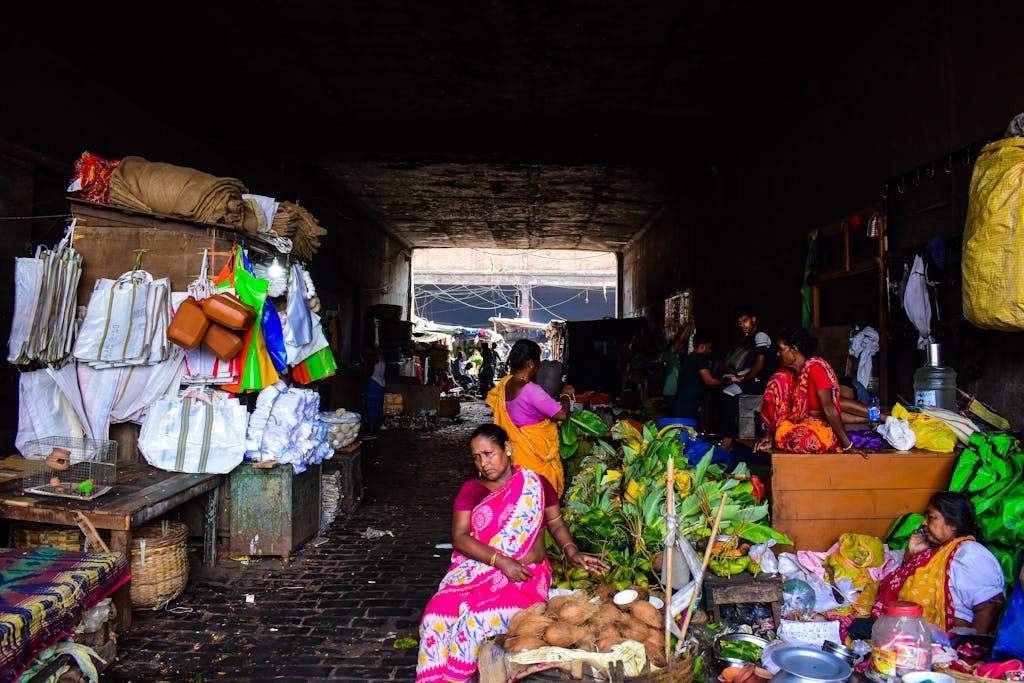India’s Unorganised Sector is a crucial yet often overlooked component of the nation’s economy, employing over 90% of the workforce while contributing significantly to GDP. This blog explores the challenges faced by this sector, its impact on the economy, and potential pathways for reform and growth.
Defining the Unorganised Sector in India
India’s unorganised sector, comprising around 94% of the workforce, plays a pivotal role in the economy. However, it faces numerous challenges, primarily due to a lack of formal recognition and support. This sector includes various small-scale industries, street vendors, and informal laborers who contribute significantly to the country’s GDP but often remain invisible in policy discussions.
Characteristics of the Unorganised Sector
- Employment Size: The unorganised sector employs a staggering 90% of India’s workforce.
- Low Income Levels: A significant portion of workers in this sector earn less than 10,000 rupees per month, placing them close to the poverty line.
- Lack of Social Security: Workers in the unorganised sector typically do not have access to benefits such as health insurance, retirement funds, or job security.
- Informal Operations: Many businesses operate without proper registration, making it challenging to track their contributions and needs.
Impact on the Economy
The unorganised sector is often referred to as the backbone of India’s economy. It provides livelihoods to millions and accounts for a substantial part of the GDP. However, its informal nature means that it is vulnerable to economic fluctuations, and workers often find themselves without support during downturns.
Micro, Small and Medium Enterprises Explained
Micro, Small and Medium Enterprises (MSMEs) form a crucial part of the unorganised sector. They are defined based on investment limits and annual turnover. Despite their importance, these enterprises often struggle with access to finance, technology, and market opportunities.
| Category | Investment Limit (in INR) | Annual Turnover (in INR) |
| Micro | Up to 1 crore | Up to 5 crore |
| Small | 1 crore to 10 crore | 5 crore to 50 crore |
| Medium | 10 crore to 50 crore | 50 crore to 250 crore |
The Reality of Job Applications in India
The job market in India is increasingly competitive, especially for educated youth. Many graduates find themselves applying for positions that do not match their qualifications, leading to frustration and disillusionment.
Types of Unemployment in India
Unemployment in India is complex and multifaceted. It can be categorized into several types:
- Open Unemployment: Individuals actively seeking jobs but unable to find suitable employment.
- Underemployment: Workers engaged in jobs that do not utilize their skills or provide sufficient income.
- Disguised Unemployment: Individuals who are technically employed but have little to no work to do.
- Seasonal Unemployment: Workers who are employed only during certain seasons or periods.
The Impact of Automation on Employment
Automation continues to reshape the job landscape in India. While it enhances productivity, it often results in job losses, particularly in the unorganised sector. The rise of AI and robotics threatens many traditional jobs, leading to a growing concern over future employment opportunities.
Income Disparities: High vs Low Earners
Income inequality in India is stark, with a small percentage of the population controlling a significant share of wealth. This disparity is evident in the contrast between high earners in the organised sector and low-income workers in the unorganised sector.
GDP and the Unorganised Sector: A Proxy Problem
The unorganised sector’s contributions to GDP are often underestimated. Official statistics typically reflect the performance of the organised sector, leading to a skewed understanding of economic health. This oversight can result in policies that do not adequately address the needs of the unorganised sector.
As we delve deeper into the challenges and opportunities facing India’s unorganised sector, it becomes clear that a more inclusive approach is necessary. Addressing the needs of this sector is not just a matter of economic policy; it’s crucial for ensuring social stability and equitable growth.

Demonetisation and Its Effects on the Unorganised Sector
Demonetisation in India was a significant move that aimed to curb black money and counterfeit currency. However, it inadvertently hit the unorganised sector the hardest. This sector relies heavily on cash transactions, and the abrupt withdrawal of high denomination notes left many small businesses and laborers without working capital.
As a result, numerous businesses were forced to shut down temporarily or, in some cases, permanently. The micro sector, which employs an average of 1.7 workers, was particularly affected. Without cash flow, these businesses struggled to purchase raw materials or pay their employees. The impact was severe, leading to increased unemployment and a decline in productivity.
GST: A Misfit for India’s Economy?
The introduction of the Goods and Services Tax (GST) was touted as a revolutionary reform to simplify India’s tax structure. However, it has proven to be a misfit for many small businesses in the unorganised sector. The requirement to maintain formal accounts and file returns has created a significant burden for these enterprises, many of which operate informally.
Businesses that previously thrived without formal bookkeeping now find themselves at a disadvantage. Unlike their organised counterparts, they are unable to avail input tax credits, resulting in higher operational costs. Consequently, demand has shifted from the unorganised to the organised sector, further exacerbating the challenges faced by small businesses.
Industry Shifts: From Unorganised to Organised
The shift in demand from unorganised to organised sectors is evident across various industries. For instance, the pressure cooker industry witnessed a significant transformation post-GST. The chairman of a leading pressure cooker company noted the decline of unorganised units as they struggled to cope with the regulatory requirements of GST.
Similar trends are seen in the luggage and leather goods industries, where organised players are gaining market share at the expense of smaller, unorganised units. This trend highlights the urgent need for policy reforms that can support the unorganised sector and allow it to compete effectively.
The Black Economy: Consequences and Solutions
The prevalence of the black economy in India poses a significant challenge to the formal economy. Corruption, tax evasion, and informal employment practices hinder economic growth and development. The unorganised sector, which constitutes a substantial part of the black economy, suffers from a lack of formal recognition and support.
To address these issues, it is crucial to enhance transparency and accountability in both the public and private sectors. Implementing stricter regulations against corruption and promoting formalisation of unorganised enterprises can help bridge the gap between the two sectors.
| Year | GDP Growth Rate (%) | Unorganised Sector Growth Rate (%) |
| 2015 | 7.5 | -2.5 |
| 2016 | 8.0 | -3.0 |
| 2017 | 7.0 | -5.0 |
| 2018 | 7.5 | -4.5 |
Missed Opportunities: India’s Economic Potential
India’s unorganised sector holds immense potential for economic growth. With over 90% of the workforce employed in this sector, there is a significant opportunity to harness its capabilities for national development. However, the lack of formal recognition and support has resulted in missed opportunities for innovation and growth.
Investing in the unorganised sector through skill development and access to finance can unlock its potential. By empowering these businesses, India can enhance productivity and create job opportunities, ultimately driving economic growth.
Balancing Organised and Unorganised Sectors
Creating a balance between the organised and unorganised sectors is vital for India’s economic stability. While the organised sector is essential for large-scale production and exports, the unorganised sector provides employment and livelihoods to millions. Policies should aim to create an ecosystem where both sectors can thrive.
This can be achieved through initiatives that promote collaboration between organised and unorganised businesses. Encouraging partnerships can enhance knowledge sharing and provide unorganised enterprises with access to better resources and markets.

Strategies to Support the Unorganised Sector
To uplift the unorganised sector, several strategies can be implemented:
- Access to Finance: Providing microloans and financial support can help businesses sustain operations and invest in growth.
- Skill Development: Training programs can enhance the skills of workers in the unorganised sector, improving productivity and employability.
- Policy Reforms: Simplifying tax regulations and providing incentives for formalisation can encourage unorganised businesses to transition into the formal economy.
- Market Access: Facilitating access to markets through digital platforms can help unorganised businesses reach a broader customer base.
The Future of GST and Its Alignment with Indian Economy
The future of GST in India depends on its ability to adapt to the unique needs of the economy. Simplifying the tax structure and reducing compliance burdens can help the unorganised sector thrive. A last-point tax system may be more appropriate for India’s economic landscape, allowing businesses to operate more freely.
Furthermore, aligning GST policies with the realities of the unorganised sector will foster growth and ensure that the benefits of economic reforms reach all segments of society.
The Political Weight of the Bottom Economy
The political landscape in India often overlooks the needs of the unorganised sector. With a majority of the population employed in this sector, it is crucial for political parties to address their concerns and needs. Mobilising the unorganised workforce can lead to greater political representation and influence.
Encouraging grassroots movements and supporting trade unions can empower workers in the unorganised sector, allowing them to voice their demands effectively. This can lead to policies that are more inclusive and supportive of their needs.
Pathways to Becoming a Developed Nation
For India to achieve developed nation status, it must address the challenges faced by the unorganised sector. A comprehensive approach that includes education, health, and infrastructure development can create a conducive environment for growth.
Investing in human capital and ensuring equitable access to resources will empower the unorganised sector, driving economic progress and reducing poverty. Only then can India aspire to become a developed nation.
Challenges of Nationalism and Regional Politics
Nationalism and regional politics can often overshadow the needs of the unorganised sector. Political parties may prioritize their agendas over the welfare of the workforce, leading to policies that do not address the root causes of poverty and unemployment.
To create a more equitable society, it is essential to focus on inclusive policies that take into account the needs of all citizens, particularly those in the unorganised sector.
Concluding Thoughts: The Need for Change
India’s unorganised sector is a vital part of the economy that requires urgent attention. Addressing its challenges through effective policies and support systems can unlock its potential for growth and development. Acknowledging the significance of this sector and working towards its upliftment is crucial for India’s future.
As we move forward, we must strive for a balanced approach that fosters collaboration between the organised and unorganised sectors, ensuring that every citizen can benefit from India’s economic progress.
Feeling tired through out the day?
ReEarthy has natural solutions for you
FAQs
- What percentage of India’s workforce is employed in the unorganised sector? Over 90% of India’s workforce is employed in the unorganised sector.
- How does demonetisation affect the unorganised sector? Demonetisation severely impacted cash-dependent businesses, leading to closures and job losses.
- What is GST, and why is it challenging for the unorganised sector? GST is a tax reform that requires businesses to maintain formal accounts, which many unorganised sector enterprises struggle with.
- What strategies can support the unorganised sector? Access to finance, skill development, policy reforms, and market access are essential strategies.
- How can India become a developed nation? By addressing the challenges of the unorganised sector and fostering inclusive growth through education, health, and infrastructure development.
